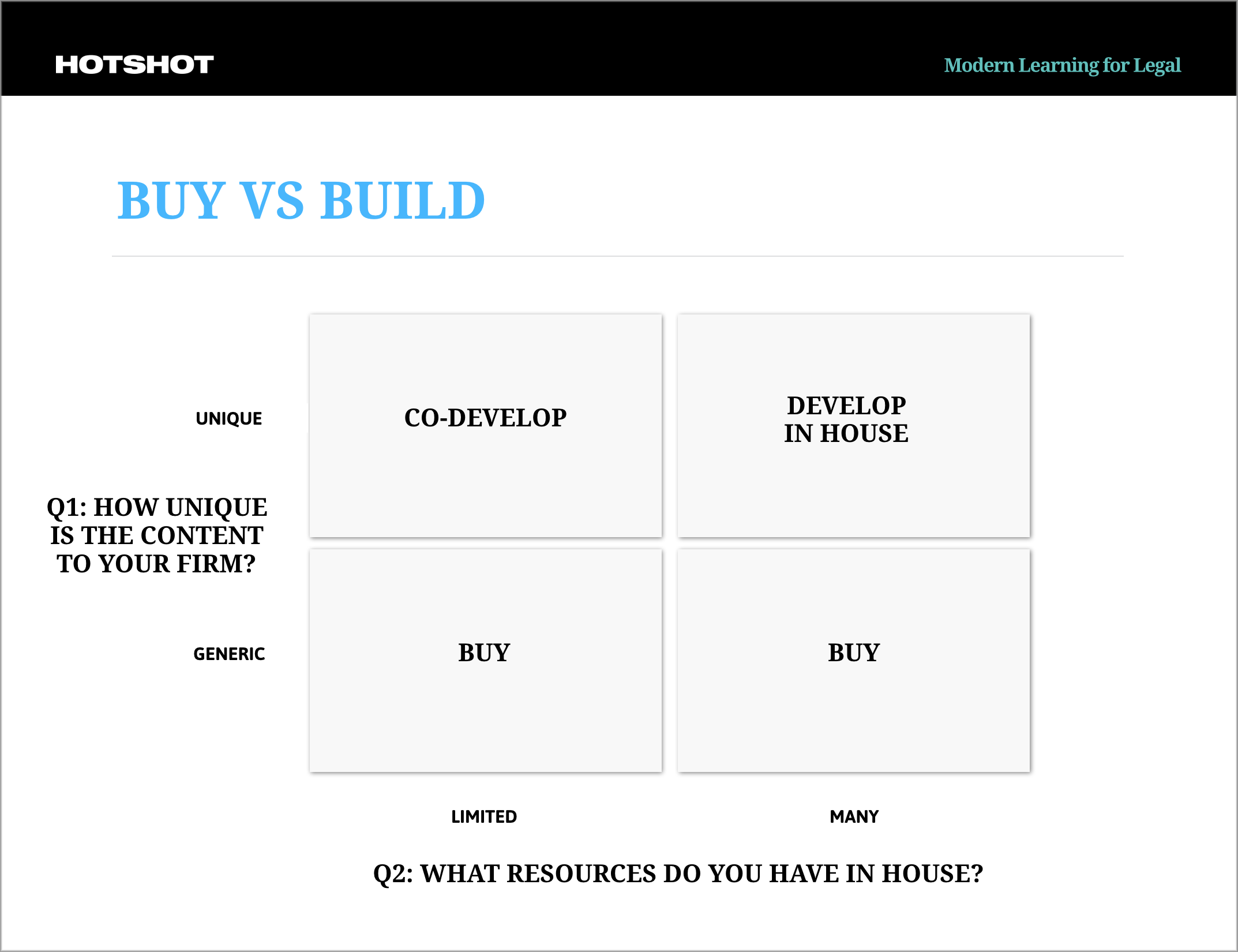Buy or Build? A Framework for Deciding When to Create or Outsource Training Content
By Chris Wedgeworth

Sometimes it makes sense for your law firm to create its own training content. But unless the topic is truly unique to your firm, there’s probably a better way to use your internal resources. Here's how Hotshot and Fenwick & West think about the buy-versus-build decision.
Ian and I have attended a few professional development meetings recently, and one question that keeps coming up is “When should law firms create their own training content and when should they outsource it?”
The image above shows a slide that we’ve been using as a way to think that question through. It offers a framework for professional development teams to make strategic choices on the buy versus build decision, allowing them to use their budgets and internal resources wisely.
We suggest that you ask yourselves two questions when thinking about how to create training content:
- Question 1: How unique is the content to your firm?
- Question 2: What resources do you have in house to create the content?
Q1: How unique is the content?
If the content you plan to deliver is very specific to your firm – say about internal procedures or how your firm manages client relationships – then the firm should definitely be involved in creating the content, and a custom approach is called for. As the top row of the above grid suggests, the extent of your involvement depends on the answer to Question 2, which we’ll come back to in a moment.
Our professional development friends at law firms tell us that sometimes they need to challenge the partners about the meaning of “unique” when discussing Question 1. Some partners’ initial tendency might be to think that the topic in question is unique to the firm, but they often change that position when they realize the costs and time involved in creating good training material from scratch. Our analysis shows that it’s over 90% cheaper and much faster for a firm to buy content from outside compared to developing it themselves, so it makes financial sense to look at Question 1 in an objective way.
Q2: What resources do you have?
The second question is about your internal resources. If you’ve concluded that the content in question really is unique to your firm, then you need to take a hard look at your internal resources and expertise. That includes money and time, of course, but also the technical know-how you need to put together effective training materials. If you’re thinking about elearning, this is more than putting a video camera at the back of a room and pressing record – you need to think about how to make the content concise and compelling and the materials visually attractive and mobile ready.
When you’re dealing with unique content and have a good set of internal resources (the top right box of the grid) then you’re in a good position to develop the content in house. If not, you’ll probably want to co-develop it (the top left box) with an outside company who can help with whatever you’re lacking (time, expertise or whatever).
If your answer to Question 1 is that the content is not unique to your firm, our proposition is that you should buy that content from elsewhere, even if you’re flush with people and money (the bottom left and right boxes). The way we see it, even the richest law firms have better things to spend their money on that re-creating training materials that are very similar to what many other law firms are using. This is the approach we’ve seen taken in industries outside legal, such as consulting firms.
The Fenwick & West Approach
One of our customers, Fenwick & West, saw our matrix above and adapted it to their own internal decision making on the buy-versus-build choice. They ask themselves five key questions:
- How unique is the content?
- How frequently will the content be used?
- Who and how many will use the content?
- How often will the content need to be updated?
- What resources do we have in house?
Kristin Heryford and Jeanne Picht turned these questions into a decision tool that has worked very well for Fenwick. “We found that we had a few more layers to consider as we made our decisions about which content to purchase, which to co-develop with an external resource, and which to build fully with in-house resources,” explained Jeanne Picht, Director of Talent Strategy at Fenwick. See Fenwick's tool here.
Download the slide
If you think this framework could be useful at your firm, feel free to use and adapt this PowerPoint slide in your internal discussions. (We’ve removed the Hotshot branding from this version).